The document discusses the development of an adaptive learning expert system for the diagnosis and management of viral hepatitis, particularly hepatitis B and C, which are significant global health issues. It highlights the system's ability to acquire, generalize, and discover new rules through knowledge provided by medical experts, enhancing decision-making for healthcare professionals. The paper emphasizes the importance of expert systems in improving healthcare access and quality, especially in regions like Ethiopia where chronic viral hepatitis is a major health concern.
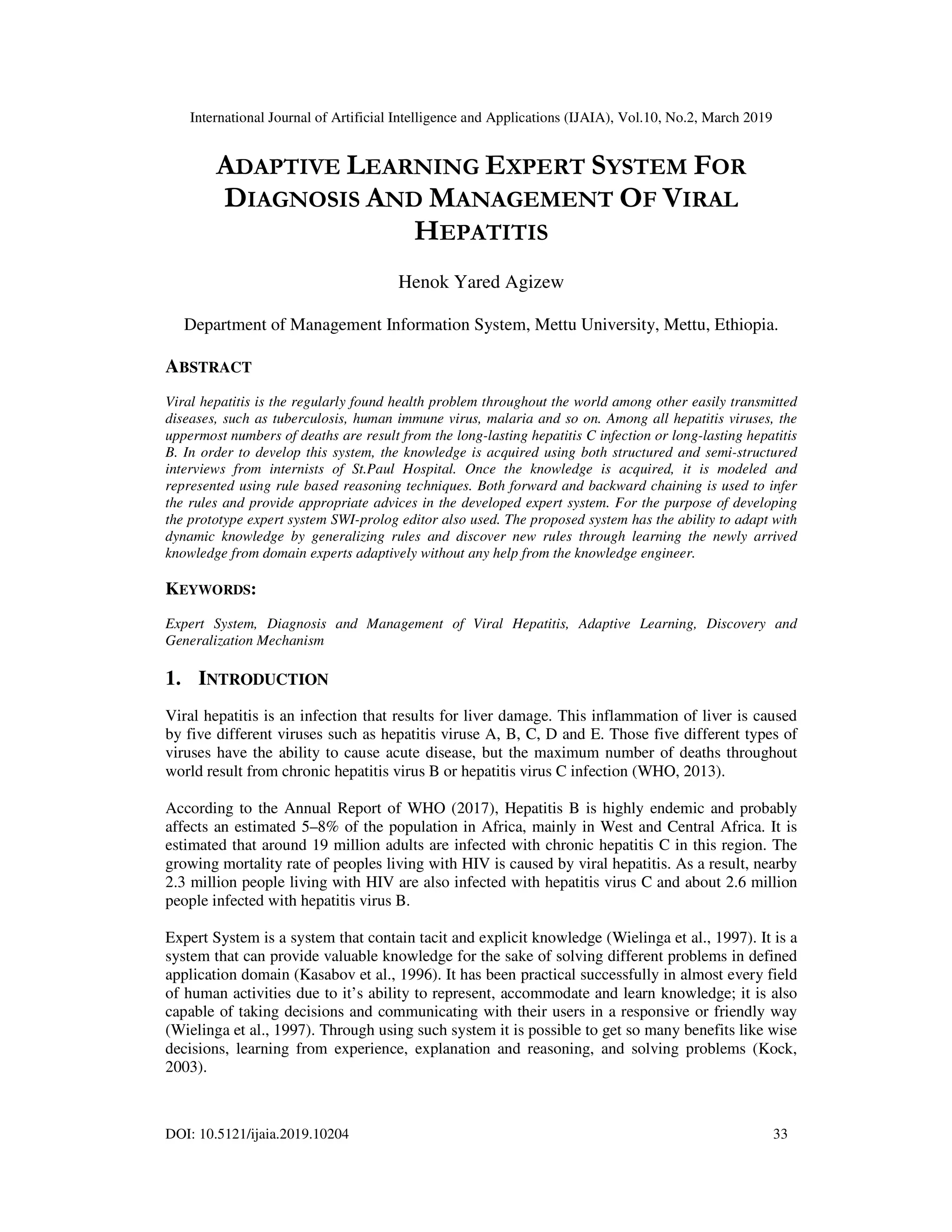
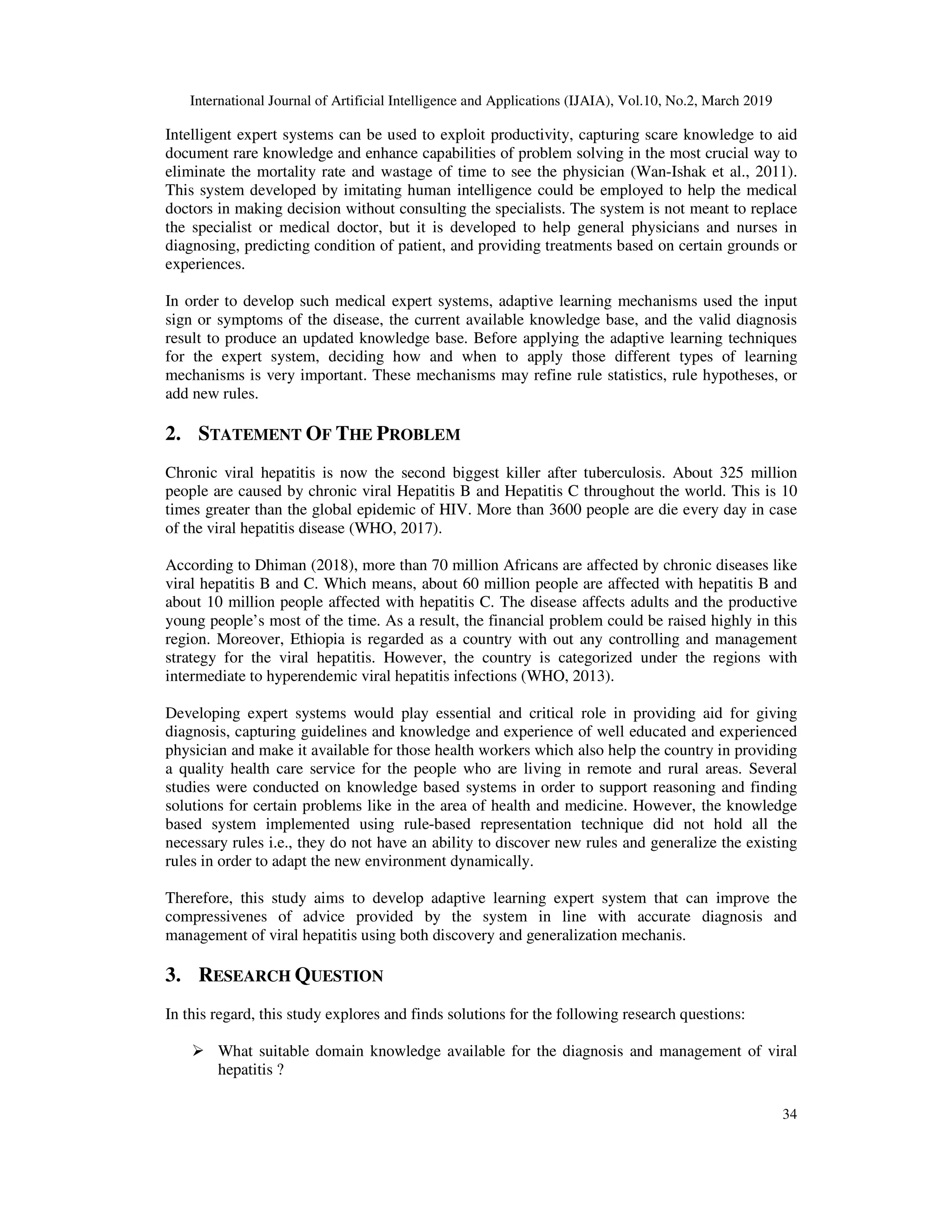
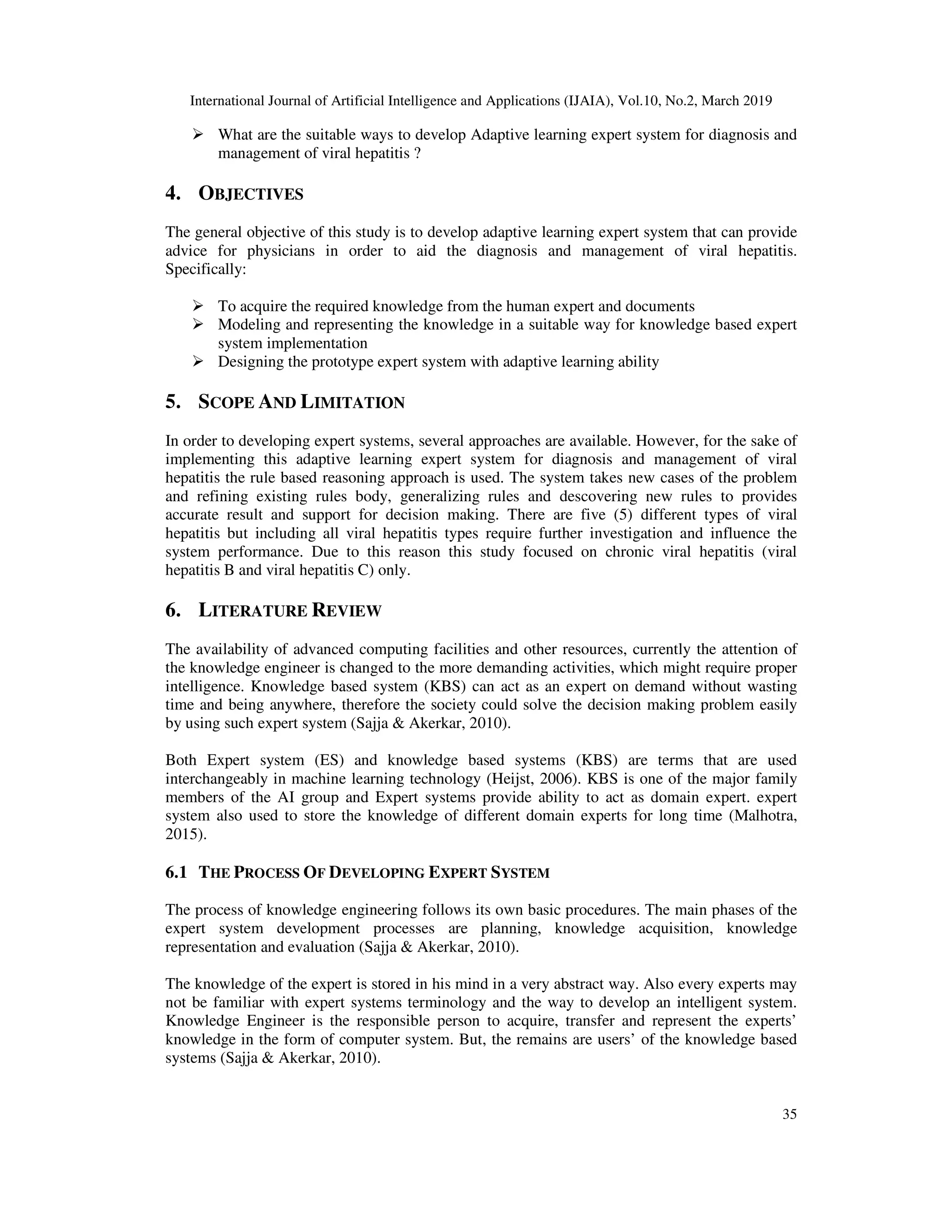
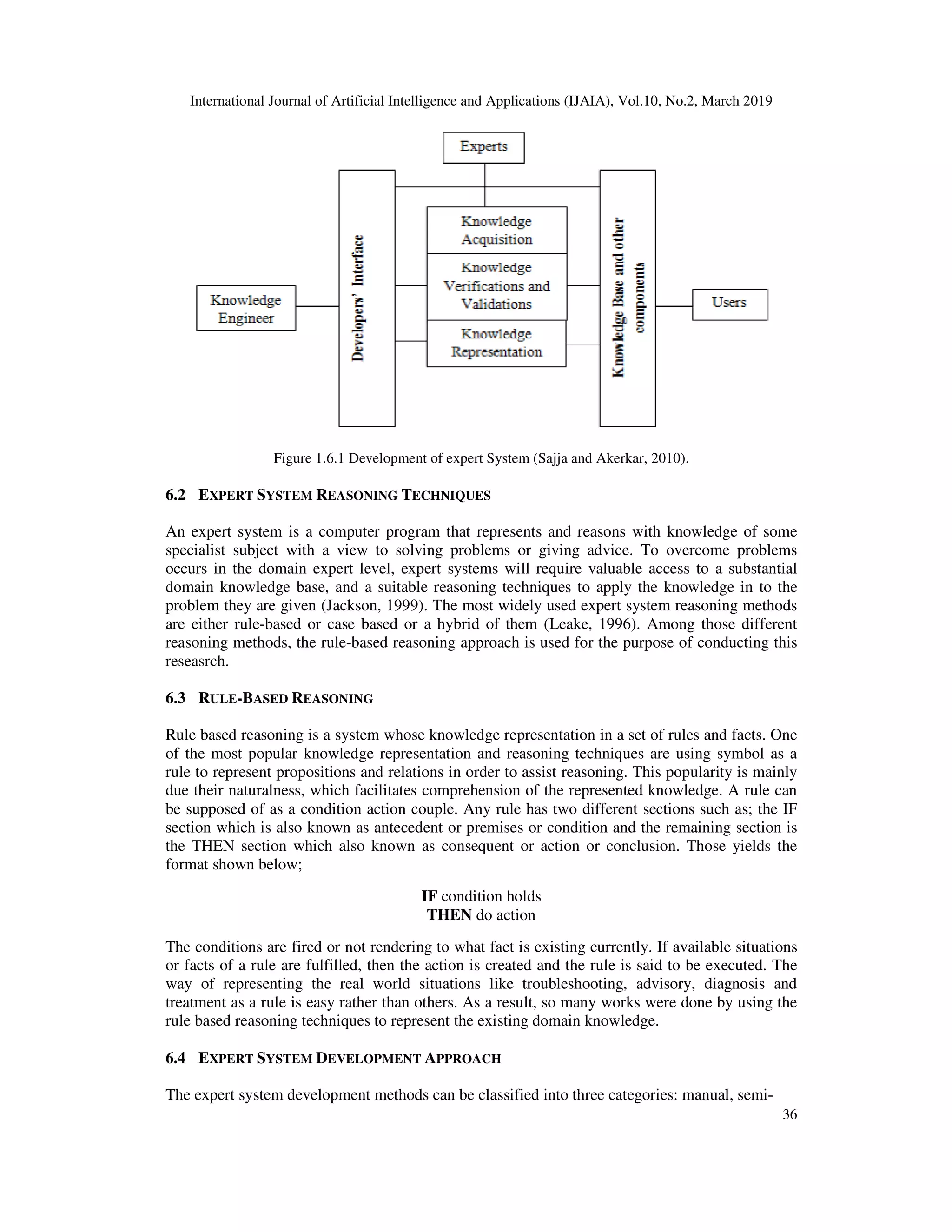

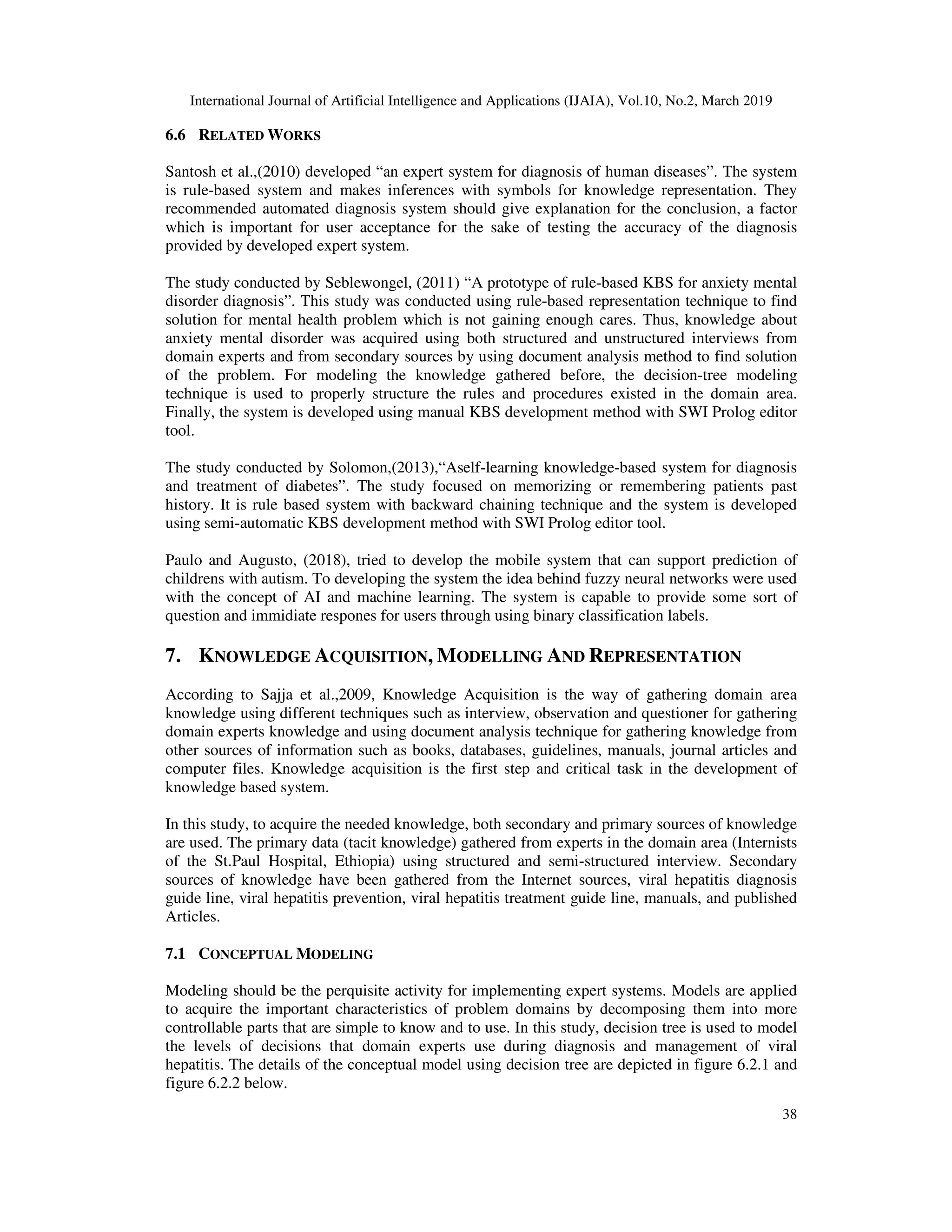

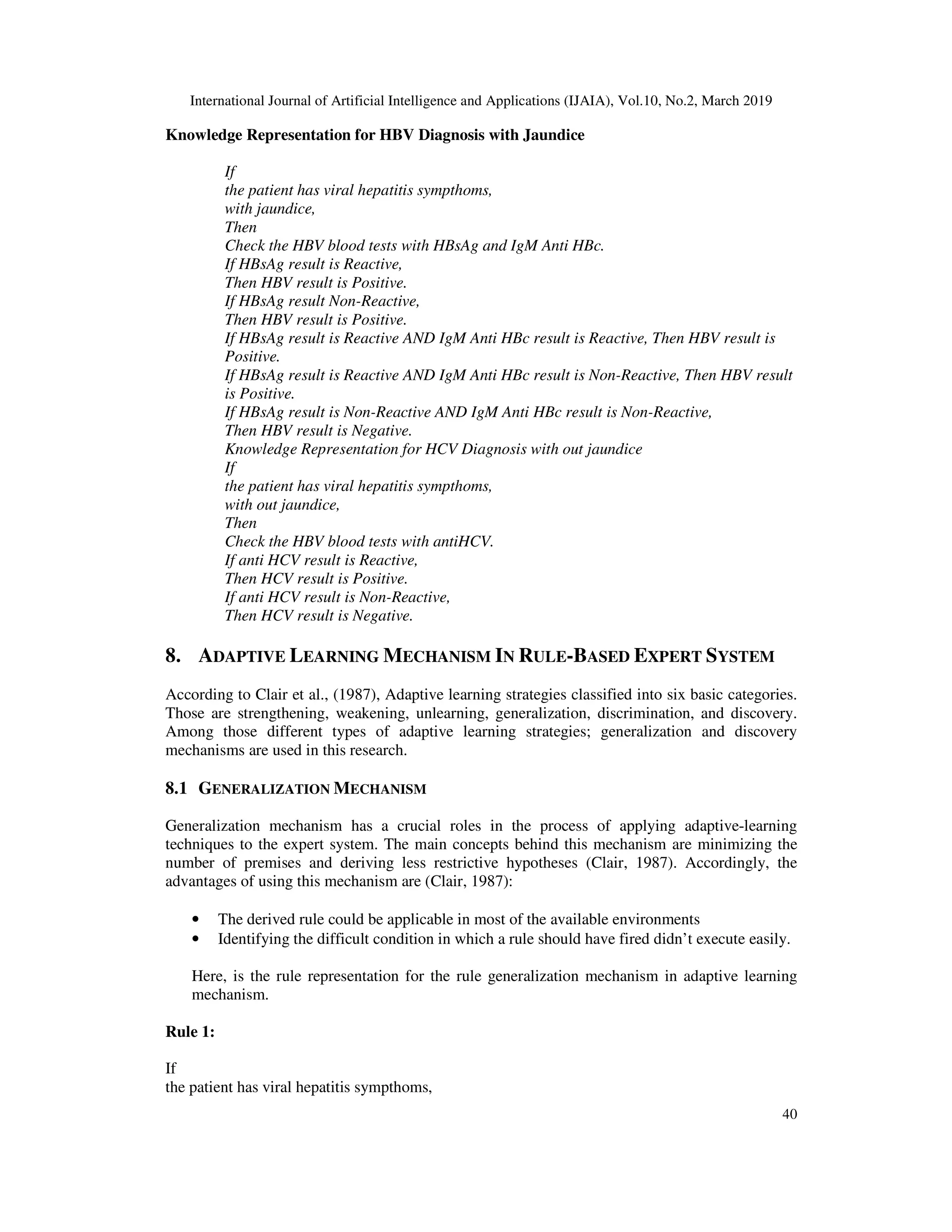
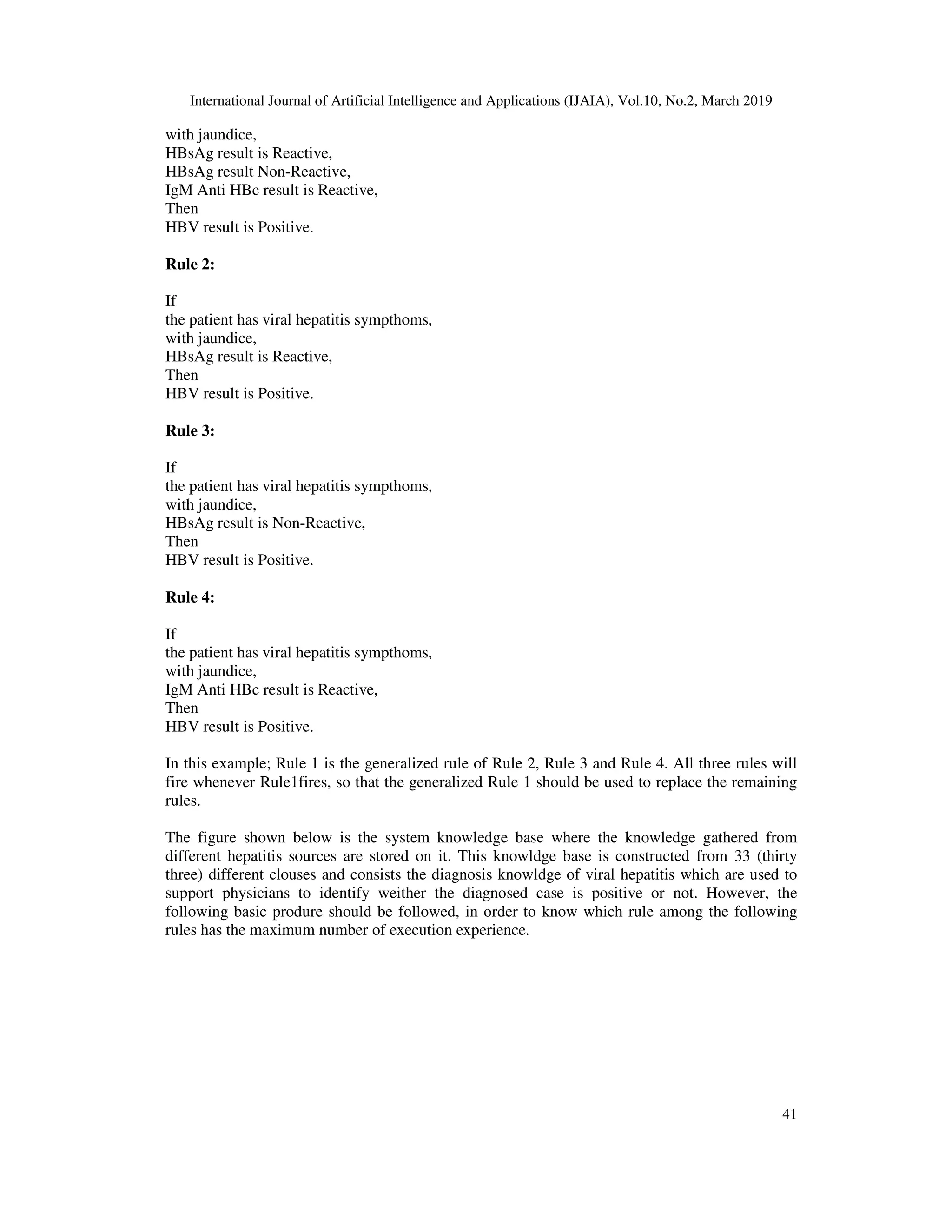
![International Journal of Artificial Intelligence and Applications (IJAIA), Vol.10, No.2, March 2019
Figure 8.0. Viral Hepatitis Knowledge Base for indicating rule experiences
1. Reconsult the knowledge base of viral hepatitis at run time
2. Induce the rule to indicate each rule’s execution experiences
3. Use the rule with the maximum number of execution exeperience to generalize the rule
Accordingly; the rule induction algorithm were used to proced the process of indicating the rule’s
execution experiences. Finally, results generated from the above sample cases of hepatitis
knowledge following those three steps are shown below;
Figure 8.0.1 Rule execution experience indicator result
As a result, here is shown the condition and action pair of sample hepatitis
indiuced from the knowledge base above. For instance;
Rule1: hbscagreact = yes
igmantihbcreact = yes => [negative/1]
International Journal of Artificial Intelligence and Applications (IJAIA), Vol.10, No.2, March 2019
Figure 8.0. Viral Hepatitis Knowledge Base for indicating rule experiences
Reconsult the knowledge base of viral hepatitis at run time
indicate each rule’s execution experiences
Use the rule with the maximum number of execution exeperience to generalize the rule
Accordingly; the rule induction algorithm were used to proced the process of indicating the rule’s
ly, results generated from the above sample cases of hepatitis
knowledge following those three steps are shown below;
Figure 8.0.1 Rule execution experience indicator result
As a result, here is shown the condition and action pair of sample hepatitis diagnosis knowledge
indiuced from the knowledge base above. For instance;
igmantihbcreact = yes => [negative/1]
International Journal of Artificial Intelligence and Applications (IJAIA), Vol.10, No.2, March 2019
42
Use the rule with the maximum number of execution exeperience to generalize the rule
Accordingly; the rule induction algorithm were used to proced the process of indicating the rule’s
ly, results generated from the above sample cases of hepatitis
diagnosis knowledge](https://image.slidesharecdn.com/10219ijaia04-190409091418/75/ADAPTIVE-LEARNING-EXPERT-SYSTEM-FOR-DIAGNOSIS-AND-MANAGEMENT-OF-VIRAL-HEPATITIS-10-2048.jpg)
![International Journal of Artificial Intelligence and Applications (IJAIA), Vol.10, No.2, March 2019
i.e. IF HBsAg result is Reactive AND IgM Anti HBc result is Reactive THEN the HBV result is
Negative. This [negative/1] indicates as the rule 1 is fired or executed only one time. While,
Rule2: hbscagreact = yes
igmantihbcreact = no => [positive/9] , this also represents;
IF HBsAg result is Reactive AND IgM Anti HBc result is Non
Positive. This [positive/9] also indicating as the rule2 is fired or executed nine (9) times.
Accordingly, among those two different rules the rule that has more number of execution time is
rule2 becouse it is fired 9 times while rule1 is fired once. Th
which can generalize the rule1 in order to provide accurate diagnosis result for physicians. Those
remaining other rules are also processed in the same manner.
8.2 DISCOVERY MECHANISM
Discovery mechanism is the proce
the current knowledge base in order to adapt with the new situation. This discovery mechanism is
very important whenever the incomplete result is provided by the system and when the system
does not have a response to the new occur situations. The figure below shows how to discover the
new rule in prolog programming language.
Figure 8.1: Discovery mechanism sample code.
International Journal of Artificial Intelligence and Applications (IJAIA), Vol.10, No.2, March 2019
i.e. IF HBsAg result is Reactive AND IgM Anti HBc result is Reactive THEN the HBV result is
[negative/1] indicates as the rule 1 is fired or executed only one time. While,
igmantihbcreact = no => [positive/9] , this also represents;
IF HBsAg result is Reactive AND IgM Anti HBc result is Non-Reactive THEN the HBV result
Positive. This [positive/9] also indicating as the rule2 is fired or executed nine (9) times.
Accordingly, among those two different rules the rule that has more number of execution time is
rule2 becouse it is fired 9 times while rule1 is fired once. Therefore, the expert system used rule2
which can generalize the rule1 in order to provide accurate diagnosis result for physicians. Those
remaining other rules are also processed in the same manner.
Discovery mechanism is the process of discover new rules through utilize input symptoms and
the current knowledge base in order to adapt with the new situation. This discovery mechanism is
very important whenever the incomplete result is provided by the system and when the system
t have a response to the new occur situations. The figure below shows how to discover the
new rule in prolog programming language.
Figure 8.1: Discovery mechanism sample code.
International Journal of Artificial Intelligence and Applications (IJAIA), Vol.10, No.2, March 2019
43
i.e. IF HBsAg result is Reactive AND IgM Anti HBc result is Reactive THEN the HBV result is
[negative/1] indicates as the rule 1 is fired or executed only one time. While,
Reactive THEN the HBV result is
Positive. This [positive/9] also indicating as the rule2 is fired or executed nine (9) times.
Accordingly, among those two different rules the rule that has more number of execution time is
erefore, the expert system used rule2
which can generalize the rule1 in order to provide accurate diagnosis result for physicians. Those
ss of discover new rules through utilize input symptoms and
the current knowledge base in order to adapt with the new situation. This discovery mechanism is
very important whenever the incomplete result is provided by the system and when the system
t have a response to the new occur situations. The figure below shows how to discover the](https://image.slidesharecdn.com/10219ijaia04-190409091418/75/ADAPTIVE-LEARNING-EXPERT-SYSTEM-FOR-DIAGNOSIS-AND-MANAGEMENT-OF-VIRAL-HEPATITIS-11-2048.jpg)
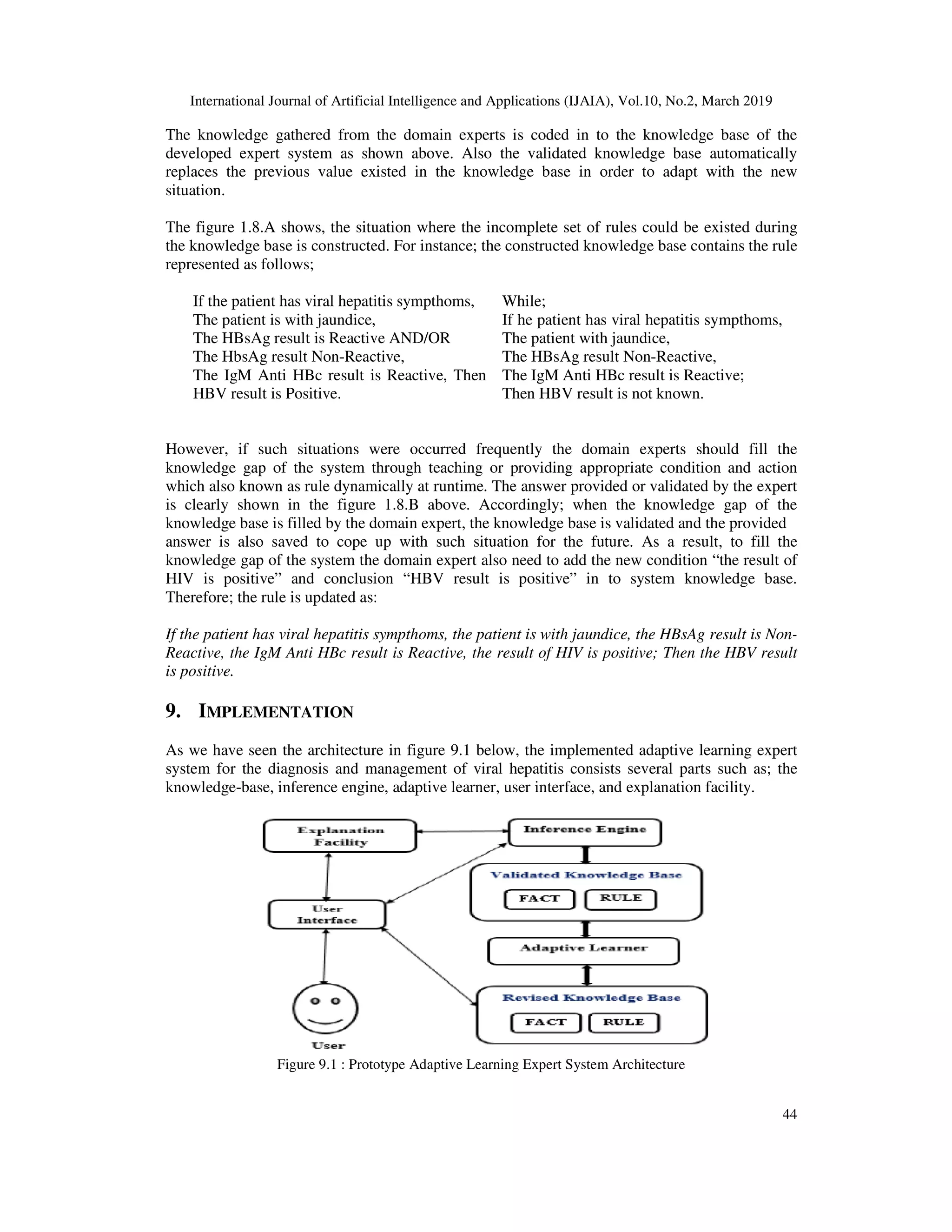
![International Journal of Artificial Intelligence and Applications (IJAIA), Vol.10, No.2, March 2019
45
10. CONCLUSION AND RECOMMENDATIONS
For the purpose of developing this adaptive learning expert system, tacit knowledge is acquired
from domain experts by using structured and semi-structured interviwing techniques and also
explicit knowledge is gathered from medical documents through document analysis technique.
Once the appropriate knowledge is gathered, it is modeled by using decision tree to simulate
procedures involved in diagnosis and management of viral hepatitis. Finally, the knowledge is
represented using a rule-based knowledge representation methods and also SWI-prolog editor
tool is used for codification of the represented knowledge. Among, those five (5) different types
of viral hepatitis the scope of this study is limited on viral hepatitis B and viral hepatitis C only.
The following recommendations are forwarded based on the discusion of the findings of the
study:
In order to evercome each and every problems of the viral hepatitis the scope of the study
should be extended.
The system needs to be integrated with other languages like C#, VB, or Java.Net to have a
more attractive look. Therefore, further research to design a user friendly user interface with
the capability to use local languages is needed.
Acquiring knowledge about the diagnosis and management of viral hepatitis is another
challenge during knowledge acquisition from the domain experts using interviewing
method. As a result, it is important to use the data mining tools and technics to filter out the
hidden domain knowledge about the disease as a feature work of line.
REFERENCES
[1] Amanuel, A. (2016).”Self Learning Computer Troubleshooting Expert System.” International Journal
of Artificial Intelligence & Applications (IJAIA). 7(1), pp.45-58.
[2] Blaxton, T.A & Kushner, B.G. (1986). “An Organizational Framework for Comparing Adaptive
Artificial Intelligence Systems.” ACM Fall Joint Computer Conference, 3(2):190-199
[3] Clair, D. C., Bond, W. E., Flachsbart, B. B., and Vigland, A. R. (1987). “An Architecture for
Adaptive Learning in Rule-Based Diagnostic Expert Systems.” Proceedings of the Fall Joint
Computer Conference, IEEE Computer Society. pp. 678-685.
[4] Dhiman, RK. (2018). National Guidelines for Diagnosis & Management of Viral Hepatitis, National
Health Mission, India.
[5] Dipanwita, Biswas, Sagar Bairagi, Neelam Panse & Nirmala Shinde. (2011). Disease Diagnosis
System. International Journal of Computer Science & Informatics, 1(2):48-51.
[6] Durkin. J. (1996). Expert Systems: A View of the Future. IEEE Expert, University of Akron, 56-63.
[7] Heijst.(2006).“Conceptual Modelling for Knowledge-Based Systems.” Encyclopedia of Computer
Science and Technology, Marce Dekker Inc., New York.
[8] Malhotra.(june, 2015) “Evolution of Knowledge Representation and Retrieval Techniques.” I.J.
Intelligent Systems and Applications. [online]. 2015 (7), pp. 18-28.](https://image.slidesharecdn.com/10219ijaia04-190409091418/75/ADAPTIVE-LEARNING-EXPERT-SYSTEM-FOR-DIAGNOSIS-AND-MANAGEMENT-OF-VIRAL-HEPATITIS-13-2048.jpg)
![International Journal of Artificial Intelligence and Applications (IJAIA), Vol.10, No.2, March 2019
46
[9] Paulo,V and Augusto,J. (2018). “Using fuzzy neural networks for improving the prediction of
children with autism through mobile devices.” ISCC 2018 Workshops - ICTS4eHealth 1570446039.
Available: https://www.researchgate.net/publication/329033556.[Nov., 2018].
[10] Sajja, P., & Akerkar, R. (2010). Knowledge-Based Systems for Development. In P. Sajja, & R.
Akerkar, Advanced Knowledge Based Systems: Model, Applications & Research, 1(1):1 – 11.
[11] Seblewongel, E. (2011). “Prototype knowledge based system for anxiety mental disorder diagnosis.”
Master’s Thesis, Addis Abeba University, Addis Abeba, Ethiopia.
[12] Solomon, G. (2013). “A self-learning knowledge based system for diagnosis and treatment of
diabetes.” Master’s Thesis, Addis Abeba University, Addis Abeba, Ethiopia.
[13] Tesfamariam, M. A. (2015). Integrating Data Mining Results with the Knowledge Based for
Diagnosis and Treatment of Visceral Leishmaniasis. Master’s Thesis, University of Gonder, Gonder,
Ethiopia.
[14] World Health Organization,(2013). Global health impact report of viral hepatitis.
[15] World Health Organization,(2017). “Prevention, Care and Treatment of Viral Hepatitis in the African
Region: Framework for Action,2016-2020 Regional Office for Africa.”](https://image.slidesharecdn.com/10219ijaia04-190409091418/75/ADAPTIVE-LEARNING-EXPERT-SYSTEM-FOR-DIAGNOSIS-AND-MANAGEMENT-OF-VIRAL-HEPATITIS-14-2048.jpg)